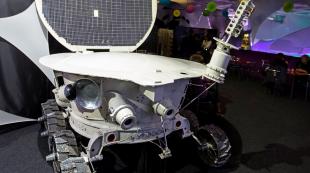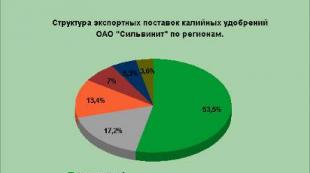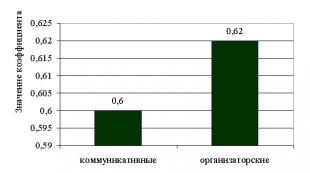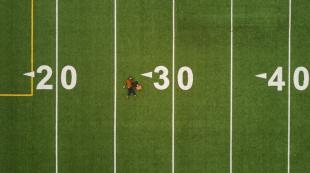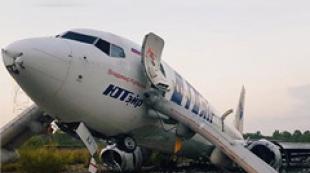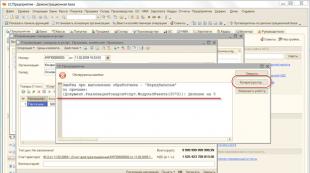The first lunar rover on the moon. Why did the USSR send “lunar rovers” to the moon? Why were the lunar rover operators classified?
If we assume that we have no brothers in mind, this transport can be considered the most reliable in the entire Universe. The Americans don't count: they repaired their Lunar Rover twice right on the Moon. Our “Lunokhod”, if it had broken down during the “flight”, there would have been no one to repair it - the crew was 400 thousand kilometers away from it...
Drone chassis
In the exploration of other planets, we, as has happened more than once, also went our own way. Instead of a human, the USSR decided to send a robotic explorer to a neighboring planet.
In order for him to be able to do everything that a living astronaut could do, he needed a vehicle. The key problem was the chassis, and the military research institute from Leningrad, which designed the chassis, was assigned to solve it. Military designers settled on the good old wheel, rejecting the caterpillar track, walking, jumping, rolling... There were several defining requirements for the Lunokhod chassis.
First of all, the propulsion device must be so universal that it minimizes the likelihood of “planting” the rover - there will be no one to push it! And, as life will show, space robots have problems with “swinging.” In addition, the tread profile was supposed to prevent the vehicle from sliding sideways when driving on slopes. Secondly, reliability is important, and what could be simpler than a wheel? Here, by the way, thirdly, due to its simplicity, the wheel as such is an extremely light unit. Finally, it is one of the most efficient propulsion systems and requires the least energy consumption. The use of a chassis with wheels makes it possible to vary their number, and in addition to reducing pressure on the ground, it is also an opportunity to increase the survivability of the vehicle - by eliminating failed wheels from the game.

The wheel is reinvented
True, the wheel had to be significantly modified, primarily because at the end of the 1960s people knew very roughly what lunar soil was. The combination of stones of all calibers with loose rocks of unpredictable density required a wheel with contradictory properties. And the military did this. Three thin titanium rims rolled easily on a hard surface, the mesh stretched between them came into action on loose soil when the rims began to fail. Angle lugs welded on top of everything helped to rake on a loose surface under load. As it turned out later, they were in demand more often than we would like. Light spokes instead of discs provided the necessary strength and elasticity in case of hard contact of the wheel with stones.

The final version of the wheels was born as a result of calculations and numerous tests. The prototypes were rolled at three training grounds with different types of soil and even in the compartment of an airplane simulating lunar gravity, which is 1/6 of Earth’s. For example, it took a lot of time to select the size of the mesh cell stretched over the rim.
A DC electric motor with a gearbox and a squib was built into the thin wheel hub. The latter was undermined remotely in the event of an emergency jamming of the drive, and the wheel, thus disconnected from the gearbox axis, turned from a driver into a driven one, that is, it simply rolled along the surface. In this way, it was possible to “repair” the drive of five wheels out of eight available without direct human intervention, and the device could continue performing the task with the three remaining drive wheels!
Nerves 400 thousand km long
The most difficult point in the USSR lunar project was the control of the Lunokhod. It was remote, and it was difficult to find a more remote one: the distance from the Sea of Rains on the Moon, where our space robot landed, to the Center for Deep Space Communications in Crimea, where its crew was located, exceeded 400,000 kilometers.

The command radio signal covered this path in 2.5 seconds, that is, with such a delay the device responded to the driver’s commands. But that wasn't the main problem. The main difficulty was the speed of updating the image on the monitor in front of the operator. The transmission of images from the Lunokhod cameras to Earth was only called television; in fact, the driver saw in front of him, to put it mildly, a slide show: the frame changed not 25 times per second, but once every 3–20 seconds (depending on the terrain )! There is nothing to be done - communication channels and computing machines of that time could not provide faster data transfer. Thus, after detecting an obstacle, the car continued to move for at least 8 seconds! That is why drivers never drove faster than 2 km/h.
The problem was aggravated by the peculiarities of lunar lighting - so sharp and contrasting that the traffic situation “behind the windshield” looked to the operator as a set of black and white spots. On some days, when the sun was at its zenith, it was impossible to “travel” at all. Therefore, to help the driver’s eyes, the device sent him data from additional sensors: roll, trim, load and wheel slip. Analyzing them, the crew quickly understood what was happening to their car: it tilted over a rocky ridge, descended into a crater, climbed out of it with 90 percent slipping... The crew’s work was so intense that he couldn’t stand it for more than two hours “behind the wheel.” .
1 / 6
2 / 6
3 / 6
4 / 6
5 / 6
6 / 6
What is inside?
By the way, about the crew. It consisted of five people. In addition to the driver, who sat on the levers (he turned the Lunokhod like a tank, with the wheels braking), there were also a navigator, a flight engineer, a highly directional antenna operator, and a crew commander. Be that as it may, even under other favorable conditions, all these people could not fit in their car, since its rounded body (max. diameter 2,150 mm) is completely occupied by scientific equipment and systems responsible for the operation of the chassis. The rover's propulsion motors were powered by silver-cadmium batteries, which were charged by solar panels placed on the top hinged cover. At night (one lunar night, like a lunar day, lasts almost 14 Earth days), the lid was closed to conserve heat in the body, and the device froze during this time in “anabiosis.” The reason is not the lack of powerful headlights, but the lack of ability to recharge batteries without the sun.
1 / 2
2 / 2
One of the key systems of the Lunokhod was the climate control system, which provided the desired temperature in a sealed housing at an outside temperature of –150 °C at night and +150 °C during the day. The heat source was a capsule containing the radioisotope Polonium-210, and excess heat was removed through the roof of the housing, which was a radiator. The coolant gas circulated inside the housing through two circuits, the second being allocated for equipment with a particularly strict thermal regime. The efficiency of the climate control of that time was so high that it made it possible not to worry about the safety of the equipment when the temperature difference between the left and right sides of the device was 100 degrees!
Warranty
A total of four copies of the Lunokhod were produced, not counting the experimental versions and training copies. The very first “combat” prototype, which was later given the name “Lunokhod-0,” did not make it into space due to a rocket accident at launch. The second vehicle, named Lunokhod-1, traveled 10,540 meters on the Moon, completing many scientific tasks. The manufacturer - the defense enterprise Machine-Building Plant named after S. A. Lavochkin - guaranteed three months of uninterrupted operation of its brainchild, but Lunokhod-1 worked for almost a year, from November 17, 1970 to September 15, 1971. Operation had to be stopped after that. how the isotope heat source exhausted its resource and the “filling” of the eight-wheeled robot finally froze on a cold lunar 150-degree night...
On November 17, 1970, the Luna-17 automatic station delivered the world's first planetary rover, Lunokhod-1, to the surface of the Moon. USSR scientists successfully implemented this program and took another step not only in the race with the USA, but also in the study of the Universe.
"Lunokhod-0"
Oddly enough, Lunokhod-1 is not the first lunar rover to launch from the surface of the Earth. The path to the Moon was long and difficult. By trial and error, Soviet scientists paved the way to space. Indeed, it’s always hard for pioneers! Tsiolkovsky also dreamed of a “lunar carriage” that would move on its own on the Moon and make discoveries. The great scientist looked into the water! – On February 19, 1969, the Proton launch vehicle, which is still used to obtain the first cosmic speed necessary to enter orbit, was launched in order to send an interplanetary station into outer space. But during acceleration, the head fairing that covered the lunar rover began to collapse under the influence of friction and high temperatures - debris fell into the fuel tank, which led to an explosion and the complete destruction of the unique rover. This project was called “Lunokhod-0”.
"Korolevsky" lunar rover
But even Lunokhod-0 was not the first. The design of the device, which was supposed to move on the Moon like a radio-controlled car, began in the early 1960s. The space race with the United States, which started in 1957, spurred Soviet scientists to bold work on complex projects. The planetary rover program was taken up by the most authoritative design bureau - the design bureau of Sergei Pavlovich Korolev. Back then, they didn’t yet know what the surface of the Moon was like: was it solid or covered with a centuries-old layer of dust? That is, first it was necessary to design the method of movement itself, and only then move directly to the apparatus. After much searching, we decided to focus on a hard surface and make the chassis of the lunar vehicle tracked. This was done by VNII-100 (later VNII TransMash), which specialized in the manufacture of tank chassis - the project was led by Alexander Leonovich Kemurdzhian. The “Korolevsky” (as it was later called) lunar rover resembled in its appearance a shiny metal turtle on tracks - with a “shell” in the form of a hemisphere and straight metal fields below, like the rings of Saturn. Looking at this lunar rover, it becomes a little sad that it was not destined to fulfill its purpose.
World famous lunar rover Babakin
In 1965, due to the extreme workload of the manned lunar program, Sergei Pavlovich transferred the automatic lunar program to Georgy Nikolaevich Babakin at the design bureau of the Khimki Machine-Building Plant named after S.A. Lavochkina. Korolev made this decision with a heavy heart. He was used to being the first in his business, but even his genius could not cope with the colossal amount of work alone, so it was wise to divide the work. It should be noted that Babakin coped with the task brilliantly! It was partly to his advantage that in 1966, the automatic interplanetary station Luna-9 made a soft landing on Selena, and Soviet scientists finally received an accurate understanding of the surface of the Earth’s natural satellite. After this, adjustments were made to the lunar rover design, the chassis was changed, and the entire appearance underwent significant changes. Babakin's Lunokhod met with rave reviews from all over the world - both among scientists and ordinary people. Hardly any media in the world has ignored this brilliant invention. It seems that even now – in a photograph from a Soviet magazine – the lunar rover stands before our eyes, like a smart robot in the form of a large saucepan on wheels with many intricate antennas.
But what is he like?
The size of the lunar rover is comparable to a modern passenger car, but this is where the similarities end and the differences begin. The lunar rover has eight wheels, and each of them has its own drive, which provided the device with all-terrain qualities. The Lunokhod could move forward and backward at two speeds and make turns in place and while moving. The instrument compartment (in the “pan”) housed the equipment of the on-board systems. The solar panel opened like a piano lid during the day and closed at night. It provided recharging for all systems. A radioisotope heat source (using radioactive decay) heated the equipment in the dark, when the temperature dropped from +120 degrees to -170. By the way, 1 lunar day is equal to 24 earthly days. The Lunokhod was intended to study the chemical composition and properties of lunar soil, as well as radioactive and X-ray cosmic radiation. The device was equipped with two television cameras (one backup), four telephotometers, X-ray and radiation measuring instruments, a highly directional antenna (discussed later) and other cunning equipment.
"Lunokhod-1", or a non-children's radio-controlled toy
We will not go into details - this is a topic for a separate article - but one way or another, Lunokhod 1 ended up on Selene. An automatic station took him there, that is, there were no people there, and the lunar machine had to be controlled from Earth. Each crew consisted of five people: commander, driver, flight engineer, navigator and highly directional antenna operator. The latter needed to ensure that the antenna always “looked” at the Earth, providing radio communication with the lunar rover. There are approximately 400,000 km between the Earth and the Moon and the radio signal, with which it was possible to correct the movement of the device, traveled this distance in 1.5 seconds, and the image from the Moon was formed - depending on the landscape - from 3 to 20 seconds. So it turned out that while the image was being formed, the lunar rover continued to move, and after the image appeared, the crew could detect their vehicle already in the crater. Due to the great tension, the crews replaced each other every two hours.
Thus, Lunokhod-1, designed for 3 earthly months of operation, worked on the Moon for 301 days. During this time, he traveled 10,540 meters, examined 80,000 square meters, transmitted many photographs and panoramas, and so on. As a result, the radioisotope heat source exhausted its resource and the lunar rover “froze.”
"Lunokhod-2"
The successes of Lunokhod-1 inspired the implementation of the new space program Lunokhod-2. The new project was almost no different in appearance from its predecessor, but was improved, and on January 15, 1973, the Luna-21 spacecraft delivered it to Selena. Unfortunately, the lunar rover lasted only 4 earthly months, but during this time it managed to travel 42 km and conduct hundreds of measurements and experiments.
Let's give the floor to the driver of the crew, Vyacheslav Georgievich Dovgan: “The story with the second one turned out to be stupid. He had already been on the Earth's satellite for four months. On May 9 I took the helm. We landed in a crater, the navigation system failed. How to get out? We have found ourselves in similar situations more than once. Then they simply covered the solar panels and got out. And then they ordered us not to close it and to get out. They say, we close it, and there will be no pumping of heat from the lunar rover, the instruments will overheat. We tried to drive out and hit the lunar soil. And the lunar dust is so sticky... The Lunokhod stopped receiving solar energy recharging in the required amount and gradually lost power. On May 11, there was no longer a signal from the Lunokhod.”
"Lunokhod-3"
Unfortunately, after the triumph of Lunokhod-2 and another expedition, Luna-24, the Moon was forgotten for a long time. The problem was that her research, unfortunately, was dominated not by scientific, but by political aspirations. But preparations for the launch of the new unique self-propelled vehicle “Lunokhod-3” had already been completed, and the crews who had gained invaluable experience in previous expeditions were preparing to pilot it among the lunar craters. This machine, which absorbed all the best qualities of its predecessors, had on board the most advanced technical equipment and the latest scientific instruments in those years. What was the cost of a rotating stereo camera, the likes of which are now fashionable to be called 3D. Now “Lunokhod-3” is just an exhibit of the museum of the NPO named after S.A. Lavochkina. Unfair fate!
Lunokhod-1 was created in the design bureau of the Khimki Machine-Building Plant named after S.A. Lavochkin under the leadership of Grigory Nikolaevich Babakin. The self-propelled chassis for the Lunokhod was created at VNIITransMash under the leadership of Alexander Leonovich Kemurdzhian.
The preliminary design of the lunar rover was approved in the fall of 1966. By the end of 1967, all design documentation was ready.
The automatic interplanetary station Luna-17 with Lunokhod-1 was launched on November 10, 1970, and on November 15, Luna-17 entered the orbit of an artificial satellite of the Moon.
On November 17, 1970, the station safely landed in the Sea of Rains and Lunokhod-1 slid onto the lunar soil.
The research apparatus was controlled using a complex of equipment for monitoring and processing telemetric information based on Minsk-22 - STI-90. The Lunokhod control center at the Simferopol Space Communications Center included a Lunokhod control center, which consisted of control panels for the crew commander, the Lunokhod driver and the highly directional antenna operator, a workstation for the crew navigator, as well as a room for operational processing of telemetric information. The main difficulty in controlling the lunar rover was the time delay, the radio signal traveling to the Moon and back took about 2 seconds, and the use of low-frame television with a picture changing frequency from 1 frame in 4 seconds to 1 in 20 seconds. As a result, the total delay in control reached 24 seconds.
During the first three months of planned work, in addition to studying the surface, the device also carried out an application program, during which it worked on searching for the landing area for the lunar cabin. After completing the program, the lunar rover worked on the Moon three times longer than its originally calculated resource. During its stay on the lunar surface, Lunokhod-1 traveled 10,540 m, transmitted 211 lunar panoramas and 25 thousand photographs to Earth. The physical and mechanical properties of the surface layer of soil were studied at more than 500 points along the route, and its chemical composition was analyzed at 25 points.
On September 15, 1971, the temperature inside the sealed container of the lunar rover began to drop as the resource of the isotope heat source was exhausted. On September 30, the device did not communicate and on October 4, all attempts to contact it were stopped.
On December 11, 1993, Lunokhod-1, together with the landing stage of the Luna-17 station, was put up for auction by the Lavochkin Association at Sotheby's. With a stated starting price of $5,000, the auction ended at $68,500. According to the Russian press, the buyer turned out to be the son of one of the American astronauts. The catalog stated that the lot “rests on the surface of the Moon.”
The mass of the rover was 756 kg, the length with an open solar battery was 4.42 m, the width was 2.15 m, and the height was 1.92 m. Wheel diameter—510mm, width—200mm, wheelbase—1700mm, track width—1600mm.
On November 17, 1970, the station safely landed in the Sea of Rains. and Lunokhod-1 slid onto the lunar soil. During the first three months of planned work, in addition to studying the surface, the device also carried out an application program, during which it worked on searching for the landing area for the lunar cabin. After completing the program, the lunar rover worked on the Moon three times longer than its originally calculated resource. During its stay on the surface of the Moon, Lunokhod-1 traveled 10,540 m, surveying an area of 80,000 m2 and transmitted 211 lunar panoramas and 25 thousand photographs to Earth. The maximum speed was 2 km/h. The total duration of the active existence of the Lunokhod was 301 days 06 hours 37 minutes. During 157 sessions with the Earth, 24,820 radio commands were issued. The permeability assessment device completed 537 cycles of determining the physical and mechanical properties of the surface layer of lunar soil, and its chemical analysis was carried out at 25 points.
On September 15, 1971, the temperature inside the sealed container of the lunar rover began to drop as the resource of the isotope heat source was exhausted. On September 30, the device did not contact, and on October 4, all attempts to contact it were stopped.
A corner reflector was installed on Lunokhod 1. with the help of which experiments were carried out to accurately determine the distance to the Moon. The Lunokhod-1 reflector provided about 20 observations in the first year and a half of operation, but then its exact position was lost. In March 2010, Lunokhod 1 was discovered by researchers in LRO imagery. On April 22, 2010, a group of American scientists from the University of California at San Diego, led by Tom Murphy, reported that they were able to obtain the reflection of a laser beam from the reflector of Lunokhod 1 for the first time since 1971. Position of Lunokhod-1 on the surface of the Moon: Latitude. 38.31870°, Longitude. −35.00374°.
Lunokhod - 1- the world's first planetary rover to successfully operate on the surface of another celestial body - the Moon.
Belongs to the series of Soviet remote-controlled self-propelled vehicles “Lunokhod” for lunar exploration, worked on the Moon for eleven lunar days. It was intended to study the features of the lunar surface, radioactive and X-ray cosmic radiation on the Moon, the chemical composition and properties of the soil.
It was delivered to the surface of the Moon on November 17, 1970 by the Soviet interplanetary station Luna-17 and worked on its surface until September 14, 1971.
- Two television cameras, four panoramic telephotometers;
- X-ray fluorescence spectrometer RIFMA;
- X-ray telescope RT-1;
- Odometer and penetrometer PrOP;
- Radiation detector RV-2N;
- Laser reflector TL.
The fact that Lunokhod 1 was lost became known during another experiment on laser probing of the Moon. This was reported by NASA Jet Propulsion Laboratory employee Vladislav Turyshev.
The purpose of such experiments is to determine the distance to our natural satellite, which is gradually moving away - by about 38 millimeters per year. To do this, a powerful laser beam is directed from the Earth to the Moon, the reflected beam is caught, and the time spent traveling back and forth is recorded. And, knowing its speed, they calculate the distance.
The beam is directed at the so-called corner reflector - a kind of open box with three mirrors mounted perpendicular to each other. Any beam that hits the mirrors is reflected exactly at the point from which it was released.
Lunokhod-1 was equipped with a corner reflector. So, the Americans aimed a beam at him. But nothing was reflected. We searched the surface with the beam - again nothing. NASA is at a loss. The device seemed to have disappeared. But its coordinates are precisely known; the beam spot reaches several kilometers in diameter. It's hard to miss.
Soviet Lunokhod proves that Americans were on the Moon
Soviet Soviet Lunokhod looks like a tiny dark speck Equipment left on our natural satellite during Soviet times has been discovered.
NASA specialists have opened access to a new huge array of photographs taken by the automatic probe Lunar Reconnaissance Orbiter - it is now in orbit of the Moon.
There are more than one hundred thousand photographs. On the previous ones, taken from an altitude of only 50 kilometers, enthusiasts found landing modules of almost all American expeditions. From the first, Apollo 11, in 1969, to the last, Apollo 17.
Now, in photographs from LRO, they are looking for equipment left by the USSR - lunar rovers and automatic stations of the Luna series. And they find it.
The other day, Canadian researcher Phil Stook from the University of Western Ontario reported that he had discovered the missing Soviet Lunokhod. What looked like a real sensation.
Our Lunokhod-1 really disappeared. In 1970, it was delivered by the automatic station Luna-17. After a series of successful experiments to reflect laser pulses sent from the Earth, the self-propelled vehicle seemed to disappear. That is, the place where he stopped in the Sea of Rains region is known for sure. But there are no answers from there.
For some reason, the Americans are trying to find Lunokhod-1 by persistently searching the surface of the Moon with a laser beam. And it is difficult for them to miss - the spot area reaches 25 square kilometers. They don't find anything.
And the Canadian, as it turned out, discovered not the first, but the second device - Lunokhod-2. But he was not lost anywhere, he stood in the Sea of Clarity. Its reflectors are still functional.
Unexpected confirmation
Lunokhod 2 arrived with the Luna 21 station in 1973. She landed about 150 kilometers from Apollo 17. And according to one of the legends, the device went to the site where the Americans operated in 1972 and drove their self-propelled carriage.
It seems that Lunokhod-2, equipped with a camera, was supposed to film the equipment left behind by the astronauts. And confirm that they were really there. The USSR still had doubts, although they never officially admitted it.
Our self-propelled vehicle traveled 37 kilometers - this is a record for movement on other celestial bodies. He really could have made it to Apollo 17, but he caught loose soil from the crater rim and overheated.
In the picture, Lunokhod 2 looks like a small dark spot. And if not for the tracks from the wheels, it would probably have been impossible to find the device. Even knowing the coordinates.
The self-propelled vehicle of the Apollo 17 expedition looks just as vague. Although it is larger in size. The similarity - in the photographs - of both units, perhaps, indicates: both of them are on the Moon. Ours, for sure. No one ever doubted this. But the Americans were suspected of falsification. Apparently, in vain. They were on the moon. At least in 1972.
Sources: savok.name, dic.academic.ru, selena-luna.ru, www.kp.ru, newsland.com
On November 17, 1970, the Luna-17 automatic station delivered the world's first planetary rover, Lunokhod-1, to the surface of the Moon. USSR scientists successfully implemented this program and took another step not only in the race with the USA, but also in the study of the Universe.
"Lunokhod-0"
Oddly enough, Lunokhod-1 is not the first lunar rover to launch from the surface of the Earth. The path to the Moon was long and difficult. By trial and error, Soviet scientists paved the way to space. Indeed, it’s always hard for pioneers! Tsiolkovsky also dreamed of a “lunar carriage” that would move on its own on the Moon and make discoveries. The great scientist looked into the water! – On February 19, 1969, the Proton launch vehicle, which is still used to obtain the first cosmic speed necessary to enter orbit, was launched in order to send an interplanetary station into outer space. But during acceleration, the head fairing that covered the lunar rover began to collapse under the influence of friction and high temperatures - debris fell into the fuel tank, which led to an explosion and the complete destruction of the unique rover. This project was called “Lunokhod-0”.
"Korolevsky" lunar rover
But even Lunokhod-0 was not the first. The design of the device, which was supposed to move on the Moon like a radio-controlled car, began in the early 1960s. The space race with the United States, which started in 1957, spurred Soviet scientists to bold work on complex projects. The planetary rover program was taken up by the most authoritative design bureau - the design bureau of Sergei Pavlovich Korolev. Back then, they didn’t yet know what the surface of the Moon was like: was it solid or covered with a centuries-old layer of dust? That is, first it was necessary to design the method of movement itself, and only then move directly to the apparatus. After much searching, we decided to focus on a hard surface and make the chassis of the lunar vehicle tracked. This was done by VNII-100 (later VNII TransMash), which specialized in the manufacture of tank chassis - the project was led by Alexander Leonovich Kemurdzhian. The “Korolevsky” (as it was later called) lunar rover resembled in its appearance a shiny metal turtle on tracks - with a “shell” in the form of a hemisphere and straight metal fields below, like the rings of Saturn. Looking at this lunar rover, it becomes a little sad that it was not destined to fulfill its purpose.
World famous lunar rover Babakin
In 1965, due to the extreme workload of the manned lunar program, Sergei Pavlovich transferred the automatic lunar program to Georgy Nikolaevich Babakin at the design bureau of the Khimki Machine-Building Plant named after S.A. Lavochkina. Korolev made this decision with a heavy heart. He was used to being the first in his business, but even his genius could not cope with the colossal amount of work alone, so it was wise to divide the work. It should be noted that Babakin coped with the task brilliantly! It was partly to his advantage that in 1966, the automatic interplanetary station Luna-9 made a soft landing on Selena, and Soviet scientists finally received an accurate understanding of the surface of the Earth’s natural satellite. After this, adjustments were made to the lunar rover design, the chassis was changed, and the entire appearance underwent significant changes. Babakin's Lunokhod met with rave reviews from all over the world - both among scientists and ordinary people. Hardly any media in the world has ignored this brilliant invention. It seems that even now – in a photograph from a Soviet magazine – the lunar rover stands before our eyes, like a smart robot in the form of a large saucepan on wheels with many intricate antennas.
But what is he like?
The size of the lunar rover is comparable to a modern passenger car, but this is where the similarities end and the differences begin. The lunar rover has eight wheels, and each of them has its own drive, which provided the device with all-terrain qualities. The Lunokhod could move forward and backward at two speeds and make turns in place and while moving. The instrument compartment (in the “pan”) housed the equipment of the on-board systems. The solar panel opened like a piano lid during the day and closed at night. It provided recharging for all systems. A radioisotope heat source (using radioactive decay) heated the equipment in the dark, when the temperature dropped from +120 degrees to -170. By the way, 1 lunar day is equal to 24 earthly days. The Lunokhod was intended to study the chemical composition and properties of lunar soil, as well as radioactive and X-ray cosmic radiation. The device was equipped with two television cameras (one backup), four telephotometers, X-ray and radiation measuring instruments, a highly directional antenna (discussed later) and other cunning equipment.
"Lunokhod-1", or a non-children's radio-controlled toy
We will not go into details - this is a topic for a separate article - but one way or another, Lunokhod 1 ended up on Selene. An automatic station took him there, that is, there were no people there, and the lunar machine had to be controlled from Earth. Each crew consisted of five people: commander, driver, flight engineer, navigator and highly directional antenna operator. The latter needed to ensure that the antenna always “looked” at the Earth, providing radio communication with the lunar rover. There are approximately 400,000 km between the Earth and the Moon and the radio signal, with which it was possible to correct the movement of the device, traveled this distance in 1.5 seconds, and the image from the Moon was formed - depending on the landscape - from 3 to 20 seconds. So it turned out that while the image was being formed, the lunar rover continued to move, and after the image appeared, the crew could detect their vehicle already in the crater. Due to the great tension, the crews replaced each other every two hours.
Thus, Lunokhod-1, designed for 3 earthly months of operation, worked on the Moon for 301 days. During this time, he traveled 10,540 meters, examined 80,000 square meters, transmitted many photographs and panoramas, and so on. As a result, the radioisotope heat source exhausted its resource and the lunar rover “froze.”
"Lunokhod-2"
The successes of Lunokhod-1 inspired the implementation of the new space program Lunokhod-2. The new project was almost no different in appearance from its predecessor, but was improved, and on January 15, 1973, the Luna-21 spacecraft delivered it to Selena. Unfortunately, the lunar rover lasted only 4 earthly months, but during this time it managed to travel 42 km and conduct hundreds of measurements and experiments.
Let's give the floor to the driver of the crew, Vyacheslav Georgievich Dovgan: “The story with the second one turned out to be stupid. He had already been on the Earth's satellite for four months. On May 9 I took the helm. We landed in a crater, the navigation system failed. How to get out? We have found ourselves in similar situations more than once. Then they simply covered the solar panels and got out. And then they ordered us not to close it and to get out. They say, we close it, and there will be no pumping of heat from the lunar rover, the instruments will overheat. We tried to drive out and hit the lunar soil. And the lunar dust is so sticky... The Lunokhod stopped receiving solar energy recharging in the required amount and gradually lost power. On May 11, there was no longer a signal from the Lunokhod.”
"Lunokhod-3"
Unfortunately, after the triumph of Lunokhod-2 and another expedition, Luna-24, the Moon was forgotten for a long time. The problem was that her research, unfortunately, was dominated not by scientific, but by political aspirations. But preparations for the launch of the new unique self-propelled vehicle “Lunokhod-3” had already been completed, and the crews who had gained invaluable experience in previous expeditions were preparing to pilot it among the lunar craters. This machine, which absorbed all the best qualities of its predecessors, had on board the most advanced technical equipment and the latest scientific instruments in those years. What was the cost of a rotating stereo camera, the likes of which are now fashionable to be called 3D. Now “Lunokhod-3” is just an exhibit of the museum of the NPO named after S.A. Lavochkina. Unfair fate!
November 17 marks 40 years since the first lunar self-propelled vehicle, Lunokhod-1, was delivered to the Moon.
On November 17, 1970, the Soviet automatic station "Luna-17" delivered to the surface of the Moon the self-propelled vehicle "Lunokhod-1", intended for comprehensive studies of the lunar surface.
The creation and launch of a lunar self-propelled vehicle became an important stage in the study of the Moon. The idea of creating a lunar rover was born in 1965 at OKB-1 (now RSC Energia named after S.P. Korolev). Within the framework of the Soviet lunar expedition, the Lunokhod was given an important place. Two lunar rovers were supposed to examine in detail the proposed lunar landing areas and act as radio beacons during the landing of the lunar ship. It was planned to use the lunar rover to transport the astronaut on the lunar surface.
The creation of the lunar rover was entrusted to the Machine-Building Plant named after. S.A. Lavochkin (now NPO named after S.A. Lavochkin) and VNII-100 (now OJSC VNIITransmash).
In accordance with the approved cooperation, the Machine-Building Plant named after S.A. Lavochkin was responsible for the creation of the entire space complex, including the creation of the lunar rover, and VNII-100 was responsible for the creation of a self-propelled chassis with an automatic motion control unit and a traffic safety system.
The preliminary design of the lunar rover was approved in the fall of 1966. By the end of 1967, all design documentation was ready.
The designed automatic self-propelled vehicle "Lunokhod-1" was a hybrid of a spacecraft and an all-terrain vehicle. It consisted of two main parts: an eight-wheeled chassis and a sealed instrument container.
Each of the 8 wheels of the chassis was driven and had an electric motor located in the wheel hub. In addition to the service systems, the instrument container of the lunar rover contained scientific equipment: a device for analyzing the chemical composition of lunar soil, a device for studying the mechanical properties of soil, radiometric equipment, an X-ray telescope and a French-made laser corner reflector for point-by-point distance measurement. The container had the shape of a truncated cone, and the upper base of the cone, which served as a radiator-cooler for heat release, had a larger diameter than the lower one. During the moonlit night, the radiator was closed with a lid.
The inner surface of the cover was covered with solar cells, which ensured recharging of the battery during the lunar day. In the operating position, the solar panel could be located at different angles within 0-180 degrees in order to optimally use the energy of the Sun at its different heights above the lunar horizon.
The solar battery and chemical batteries working in conjunction with it were used to supply electricity to numerous units and scientific instruments of the lunar rover.
In the front part of the instrument compartment there were windows of television cameras designed to control the movement of the lunar rover and transmit to Earth panoramas of the lunar surface and part of the starry sky, the Sun and the Earth.
The total mass of the lunar rover was 756 kg, its length with the solar battery cover open was 4.42 m, width 2.15 m, height 1.92 m. It was designed for 3 months of operation on the lunar surface.
On November 10, 1970, a three-stage Proton-K launch vehicle launched from the Baikonur Cosmodrome, which launched the Luna-17 automatic station with the Lunokhod-1 automatic self-propelled vehicle into an intermediate circular near-Earth orbit.
Having completed an incomplete orbit around the Earth, the upper stage put the station on a flight path to the Moon. On November 12 and 14, planned corrections to the flight trajectory were carried out. On November 15, the station entered lunar orbit. On November 16, flight path corrections were made again. On November 17, 1970, at 6 hours 46 minutes 50 seconds (Moscow time), the Luna-17 station safely landed in the Sea of Rains on the Moon. It took two and a half hours to inspect the landing site using telephotometers and deploy the ramps. After analyzing the surrounding situation, a command was issued, and on November 17 at 9:28 a.m., the Lunokhod-1 self-propelled vehicle slid onto the lunar soil.
The Lunokhod was controlled remotely from Earth from the Center for Deep Space Communications. A special crew was prepared to control it, which included a commander, driver, navigator, operator and flight engineer. For the crew, military personnel were selected who had no experience in driving vehicles, including mopeds, so that earthly experience would not dominate when working with the lunar rover.
The selected officers underwent a medical examination almost the same as cosmonauts, theoretical training and practical training at a special lunodrome in Crimea, which was identical to the lunar terrain with depressions, craters, faults, and a scattering of stones of various sizes.
The Lunokhod crew, receiving lunar television images and telemetric information on Earth, used a specialized control panel to issue commands to the Lunokhod.
Remote control of the Lunokhod's movement had specific features due to the operator's lack of perception of the movement process, delays in the reception and transmission of television image commands and telemetric information, and the dependence of the mobility characteristics of the self-propelled chassis on movement conditions (relief and soil properties). This obliged the crew to anticipate with some advance the possible direction of movement and obstacles in the path of the lunar rover.
Throughout the first lunar day, the crew of the lunar rover adjusted to the unusual television images: the picture from the Moon was very contrasting, without penumbra.
The device was controlled in turns, the crews changed every two hours. Initially, longer sessions were planned, but practice showed that after two hours of work the crew was completely “exhausted.”
During the first lunar day, the landing area of the Luna-17 station was studied. At the same time, the Lunokhod systems were tested and the crew gained driving experience.
For the first three months, in addition to studying the lunar surface, Lunokhod-1 also carried out an application program: in preparation for the upcoming manned flight, it practiced searching for the landing area for the lunar cabin.
On February 20, 1971, at the end of the 4th lunar day, the initial three-month work program of the lunar rover was completed. An analysis of the state and operation of on-board systems showed the possibility of continuing the active functioning of the automatic apparatus on the lunar surface. For this purpose, an additional program for the operation of the lunar rover was drawn up.
The successful operation of the spacecraft lasted 10.5 months. During this time, Lunokhod-1 traveled 10,540 m, transmitted 200 telephotometric panoramas and about 20 thousand low-frame television images to Earth. During the survey, stereoscopic images of the most interesting features of the relief were obtained, allowing for a detailed study of their structure.
Lunokhod-1 regularly carried out measurements of the physical and mechanical properties of the lunar soil, as well as chemical analysis of the surface layer of the lunar soil. He measured the magnetic field of various parts of the lunar surface.
Laser ranging from the Earth of the French reflector installed on the lunar rover made it possible to measure the distance from the Earth to the Moon with an accuracy of 3 m.
On September 15, 1971, at the onset of the eleventh lunar night, the temperature inside the sealed container of the lunar rover began to drop, as the resource of the isotope heat source in the night heating system was exhausted. On September 30, the 12th lunar day arrived at the lunar rover’s site, but the device never made contact. All attempts to contact him were stopped on October 4, 1971.
The total time of active operation of the lunar rover (301 days 6 hours 57 minutes) was more than 3 times greater than that specified in the technical specifications.
Lunokhod 1 remained on the Moon. Its exact location was unknown to scientists for a long time. Almost 40 years later, a team of physicists led by Professor Tom Murphy from the University of California, San Diego, found Lunokhod 1 in images taken by the American Lunar Reconnaissance Orbiter (LRO) and used it for a scientific experiment to find inconsistencies in the General Theory of Relativity developed by Albert Einstein. For this study, scientists needed to measure the Moon's orbit to the nearest millimeter, which is done using laser beams.
On April 22, 2010, American scientists were able to “grope” the corner reflector of the Soviet apparatus using a laser beam sent through the 3.5-meter telescope at the Apache Point Observatory in New Mexico (USA) and receive about 2 thousand photons reflected “ Lunokhod-1".
The material was prepared based on information from open sources

